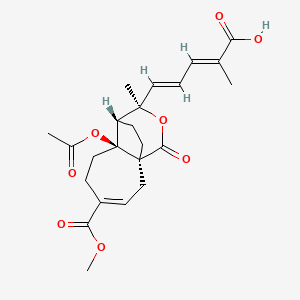Ferroptosis-centered Drug Response Information
General Information of the Drug (ID: ferrodrug0243)
| Name |
Pseudolaric acid B
|
||||
|---|---|---|---|---|---|
| Synonyms |
Pseudolaric acid B; 82508-31-4; Pseudolaric-Acid-B; Pseudolaric acid b(pba); CHEBI:189471; BCP07962; PD087135; Q-100841; (2E,4E)-5-[(1S,7S,8S,9R)-7-Acetyloxy-4-methoxycarbonyl-9-methyl-11-oxo-10-oxatricyclo[6.3.2.01,7]tridec-3-en-9-yl]-2-methylpenta-2,4-dienoic acid
Click to Show/Hide
|
||||
| Structure |
 |
||||
|
3D MOL
|
|||||
| Formula |
C23H28O8
|
||||
| IUPAC Name |
(2E,4E)-5-[(1S,7S,8S,9R)-7-acetyloxy-4-methoxycarbonyl-9-methyl-11-oxo-10-oxatricyclo[6.3.2.01,7]tridec-3-en-9-yl]-2-methylpenta-2,4-dienoic acid
|
||||
| Canonical SMILES |
CC(=CC=CC1(C2CCC3(C2(CCC(=CC3)C(=O)OC)OC(=O)C)C(=O)O1)C)C(=O)O
|
||||
| InChI |
InChI=1S/C23H28O8/c1-14(18(25)26)6-5-10-21(3)17-9-12-22(20(28)31-21)11-7-16(19(27)29-4)8-13-23(17,22)30-15(2)24/h5-7,10,17H,8-9,11-13H2,1-4H3,(H,25,26)/b10-5+,14-6+/t17-,21+,22-,23-/m0/s1
|
||||
| InChIKey |
VDGOFNMYZYBUDT-YCONPBHISA-N
|
||||
| PubChem CID | |||||
Full List of Ferroptosis Target Related to This Drug
Cystine/glutamate transporter (SLC7A11)
| In total 1 item(s) under this Target | |||||
| Experiment 1 Reporting the Ferroptosis-centered Drug Act on This Target | [1] | ||||
| Target for Ferroptosis | Suppressor | ||||
| Responsed Disease | Glioblastoma | ICD-11: 2A00 | |||
| Responsed Regulator | Cellular tumor antigen p53 (TP53) | Driver | |||
| Pathway Response | Fatty acid metabolism | hsa01212 | |||
| Ferroptosis | hsa04216 | ||||
| Cell Process | Cell ferroptosis | ||||
| Cell proliferation | |||||
| In Vitro Model | U-87MG cells | Glioblastoma | Homo sapiens | CVCL_0022 | |
| U-251MG cells | Astrocytoma | Homo sapiens | CVCL_0021 | ||
| SHG-44 cells | Astrocytoma | Homo sapiens | CVCL_6728 | ||
| In Vivo Model |
Twenty athymic BALB/c nude mice (aged 4 weeks, weight 20-22 g, from Shanghai laboratory animal Center, Shanghai, China) were housed in a specific pathogen-free environment. A total of 1 x 106 logarithmically growing C6 cells in 100 uL of PBS were subcutaneously injected into the right flank of each mouse. Therapeutic experiments were started when the tumor reached about 150 mm3 after about 7 days. The mice were allocated to receive intraperitoneal injections of vehicle (control group, n = 5/group), PAB at the dosage of 10 mg/kg body weight (n = 10/group) and 20 mg/kg body weight (n = 10/group) in the same volume 50 uL once a days for 8 times.
Click to Show/Hide
|
||||
| Response regulation | Pseudolaric acid B (PAB) improved intracellular iron by upregulation of transferrin receptor. The increased iron activated Nox4, which resulted in overproduction of H2O2and lipid peroxides. Moreover, PAB depleted intracellular GSH via p53-mediated xCT (SLC7A11) pathway, which further exacerbated accumulation of H2O2and lipid peroxides. Thus, PAB triggers ferroptosis in glioma cells and is a potential medicine for glioma treatment. | ||||
NADPH oxidase 4 (NOX4)
| In total 1 item(s) under this Target | |||||
| Experiment 1 Reporting the Ferroptosis-centered Drug Act on This Target | [1] | ||||
| Target for Ferroptosis | Driver | ||||
| Responsed Disease | Glioblastoma | ICD-11: 2A00 | |||
| Pathway Response | Fatty acid metabolism | hsa01212 | |||
| Ferroptosis | hsa04216 | ||||
| Cell Process | Cell ferroptosis | ||||
| Cell proliferation | |||||
| In Vitro Model | U-87MG cells | Glioblastoma | Homo sapiens | CVCL_0022 | |
| U-251MG cells | Astrocytoma | Homo sapiens | CVCL_0021 | ||
| SHG-44 cells | Astrocytoma | Homo sapiens | CVCL_6728 | ||
| In Vivo Model |
Twenty athymic BALB/c nude mice (aged 4 weeks, weight 20-22 g, from Shanghai laboratory animal Center, Shanghai, China) were housed in a specific pathogen-free environment. A total of 1 x 106 logarithmically growing C6 cells in 100 uL of PBS were subcutaneously injected into the right flank of each mouse. Therapeutic experiments were started when the tumor reached about 150 mm3 after about 7 days. The mice were allocated to receive intraperitoneal injections of vehicle (control group, n = 5/group), PAB at the dosage of 10 mg/kg body weight (n = 10/group) and 20 mg/kg body weight (n = 10/group) in the same volume 50 uL once a days for 8 times.
Click to Show/Hide
|
||||
| Response regulation | Pseudolaric acid B (PAB) improved intracellular iron by upregulation of transferrin receptor. The increased iron activated Nox4, which resulted in overproduction of H2O2and lipid peroxides. Moreover, PAB depleted intracellular GSH via p53-mediated xCT pathway, which further exacerbated accumulation of H2O2and lipid peroxides. Thus, PAB triggers ferroptosis in glioma cells and is a potential medicine for glioma treatment. | ||||
